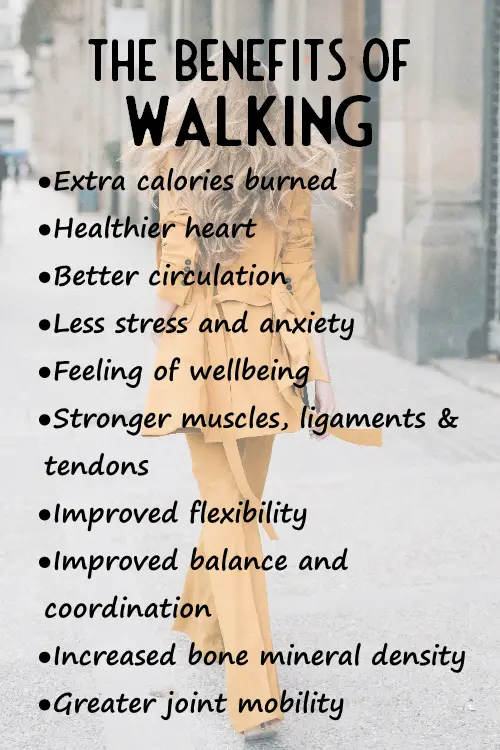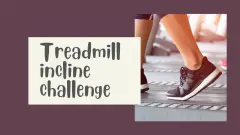Walking 3 miles a day will keep you fit and burn around 2000 calories a week. It will also keep your muscles toned and flexible and strengthen your bones, plus it has several other benefits (see below). If you don’t have time to walk 3 miles in one go, you can split your walks up over the course of the day. This post covers the benefits, the basics for getting started, planning and the advantages/disadvantages of treadmills. The printable download includes sheets to plan and track 1, 2 or 3 walks per day.
Benefits of walking 3 miles a day

#1 Burns calories
An obvious one. The more active you are, the more calories you burn.
#2 Makes your heart stronger
When we exercise, our heart has to work harder to get more blood to the working muscles. It adapts to this by growing bigger and stronger. This means we have more energy and a healthier heart.
#3 Improves your circulation
As well as improvements to heart function, the circulatory system also adapts to become more efficient at delivering the blood to the muscles.
#4 Reduces stress and anxiety
All exercise can be beneficial to mental health, but walking outdoors is particularly beneficial.
#5 Improves mood
As well as reducing stress and anxiety, exercise causes endorphins to be released, which give rise to feelings of wellbeing.
#6 Strengthens your muscles, ligaments and tendons
Although walking won’t strengthen the muscles and other tissues as much as strength training, it does have a strengthening effect.
#7 Improves your flexibility
Lack of movement makes muscles tight. Regular exercise maintains muscle length.
#8 Improves your balance and coordination
All exercise is good for balance and coordination. If you walk on different surfaces, in different weather conditions and on different gradients, all these factors help to improve balance and coordination.
#9 Helps build or maintain bone mineral density (meaning reduced risk of osteoporosis)
Loss of bone mineral density is a problem for women as we get older, especially after menopause. It makes our bones more prone to fracture and can become a serious health problem, known as osteoporosis. The best protection against loss of bone density is weight bearing exercise. After middle age, the potential to build bone density is limited, but weight bearing exercise will still help to maintain existing density. Weight bearing exercise means exercise in which we are on our feet, supporting our body weight and moving around. Obviously, walking is a good example of this.
#10 Improves joint mobility
There are two factors to being able to move all our joints freely through a wide range of movement. One is flexibility and the other is having healthy well-lubricated joints. Exercise strengthens the ligaments which keep our joints strong and stimulates the joint lining to produce lubricating fluid.
Planning your walks

Safety and wellbeing
Walking is a safe and natural activity, but please read these general exercise guidelines before starting the program.
You should wear flat, comfortable shoes for your walking. You will probably get warmer as your walking speed increases, so it’s a good idea to wear a jacket or jumper that you can easily take off and carry.
Make sure you stay well hydrated. You should take a bottle of water on your walks and sip frequently, especially on the longer walks.
Planning your route
If you’re doing your 3 miles on a treadmill, then it’s very straightforward. You just need to set the speed at whatever is your comfortable walking speed and keep going until you’ve covered the distance. If you’re walking outside, then you’ll need to decide what sort of route you want:
“There and back” – you walk half way and then turn around and walk back to where you started.
Circular route – you plot a route to bring you back where you started without turning and retracing your steps. Your route isn’t necessarily a circle, it could be any sort of shape.
“A to B” – you end up at a different location from where you started. You might walk somewhere and get a lift back for example.
If you don’t want the trouble of planning a route, you can choose the “there and back” option. But if you want to follow a circular route or end up at a different location, then it’s useful to use a route planning app.
If you’re doing the “there and back route”, you need to be able to measure when it’s time to turn around and come back. There are 3 ways you can do this:
- Using a fitness watch or app that tells you the distance you’re covering
- Timing yourself with an ordinary watch or stopwatch
- Using a step counter
Options 2 & 3 will be slightly less accurate, but good enough. Based on an average walking speed, 3 miles would take one hour, so you would need to turn around after half an hour. Based on average steps per mile, you would cover roughly 7,000 steps altogether, so need to turn around after 3,500 steps.
Breaking your 3 miles down into shorter walks
It takes about an hour to walk 3 miles. If this is difficult for you to fit in all at once, then break it down into 2 x 30 minute or 3 x 20 minute walks. You could break it down even more if necessary, but walks under 20 minutes won’t be as effective for building cardio endurance.
The printable download has sheets for 1, 2 or 3 walks a day. You can use them to schedule your walks, mark them as done and make notes that may be useful for future scheduling. For example, you could record information about your route, what else you did that day and how easy/hard you found your walk. Looking back on your notes, you will be able to see patterns of what works best for you in terms of when and where to walk. Other patterns you might notice include if there are other things that affect how much you enjoy your walk or, if you’re sometimes skipping walks, whether there’s a factor that is causing this.
Treadmill or outside?
You’ll benefit from your walking whether you do it on a treadmill or outdoors. Each has its own advantages:
Advantages of the treadmill
With a treadmill it’s easy to set your walking speed and keep your speed continuous. You don’t need to worry about route planning and, if you want the challenge of an uphill walk then it’s easy to increase the gradient. You also aren’t affected by bad weather.
Advantages of walking outside
On the other hand, the predictable conditions of the treadmill make it less of an all-over body challenge because you don’t have to cope with uneven surfaces and changes in direction. Walking in the street or park is also free of course, whereas gym membership or buying a home treadmill can be expensive. You’ll get the benefit of fresh outdoor air, which is good for mental as well as physical health.
Buying a treadmill for home use
Now that folding treadmills are widely available, having a home treadmill doesn’t mean you need a dedicated workout space. You can fold your treadmill up and store it out of the way between walks. If you’re thinking of buying a home treadmill, here are some points you should consider:
- Are you likely to run on it? If so, you should avoid very lightweight models. Also, a cushioned running/walking deck will help to absorb impact.
- Dimensions: there’s a slight variation in dimensions between models. If you’re tall, you might prefer a longer walking/running deck to allow for a longer stride. Obviously, the treadmill needs to fit in your chosen storage place when it is folded away.
- What sort of a console do you want? Is it important to you to have a multi-feature console with a choice of preset programs, or will you be happy with something simple that just lets you set speed and incline? Extra functions add to the cost of the treadmill, so think about whether you really need them.
- What is the incline range? Some treadmills only have a limited incline range. Models that offer up to 12% give you more options to vary your workouts and to challenge yourself more as your fitness improves.
- Maximum speed – if you run fast, or plan to do sprint intervals, you should bear the maximum speed in mind. For walking, or average speed running, any treadmill will be fine.
See a treadmill buying guide here.
Download the Walking 3 miles a day printable and get started
Sign up for My Fitness Planner updates and get the link for the printable schedule & tracker sheets e-mailed to you:
After you sign up, you’ll get 2 e-mails, one will have a link to your printable download and the other will be a welcome e-mail.
If the e-mails haven’t turned up within a few minutes, please check your junk folder, as some service providers have very strict filters.

